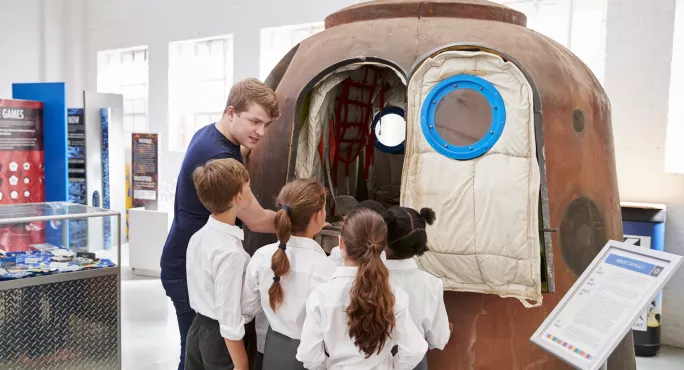How to make aerospace careers accessible

Getting children to consider pursuing a career in the aerospace industry can be hard, not least because they lack knowledge about what jobs actually exist in the sector and viable career paths - as do many teachers.
The effect is clear. Ucas data shows that from among the 2.7 million applications for university courses in 2018, just 20,345 were for aerospace engineering courses - 0.7% of the total.
But there are a range of organisations, charities and companies that can help to bring the aerospace sector to life and potentially propel pupils on a fascinating and rewarding career trajectory.
Professor Becky Parker, director of the Institute for Research in Schools (IRIS), says Stem (science, technology, engineering and maths) lessons are key to inspiring children about careers in the aerospace industry. We must help young people “to see the relevance of what they are learning and the opportunities it can lead to”, she adds.
IRIS, launched in 2016, does this by connecting schools with organisations such as the National Space Academy, which is part-funded by the National Space Centre in Leicester. The centre is home to all manner of inspiring exhibits, from a Soyuz spacecraft and a 42m-high Rocket Tower to a mock-up of the Columbus Module from the International Space Station.
Furthermore, to help ground this in reality, the academy regularly hosts events such as masterclasses, which mix education with insights into how this learning can lead to jobs in the future.
Dr Kierann Shah, general manager of the National Space Academy, explains: “In a masterclass the person leading the class will be a specialist teacher in an area like physics or chemistry and we help them meet and talk with people working in the aerospace sector so they have context to explain to the pupils how what they are learning is applied in the real world.”
The academy also hosts career conferences that bring together a diverse array of speakers, from academics to aerospace professionals, who are at various stages of their careers and from a range of backgrounds.
“We want to help people break away from the perception there is only one type of engineer and realise aerospace and other related fields are diverse industries,” Shah says.
“What’s more, most people explain they have not had a linear career path and I think that is reassuring as pupils hear there are various ways into the aerospace sector, whether through university, apprenticeships or work experience and so forth.”
There are also plenty of inspirational presenters at these events, too. In recent years, speakers have included Helen Sharman, the first British citizen in space, and Dr Suzanne Imber, a planetary scientist and winner of BBC Two’s Astronauts: Do You Have What It Takes?
A wealth of options
Another good way that schools can inspire pupils is with visits to nearby universities. Providing young people with a chance to interact with students and PhD candidates who may be only a few years older than them can encourage them to consider following a similar path.
Universities also have good industry links that schools can benefit from. The University of the West of Scotland, for example, hosts a yearly Stem Academy event. By bringing together academia and industry, this can help pupils to better understand where a career in aerospace could lead.
Higher education institutions usually have cutting-edge equipment they can show off, too, and this can inspire pupils to explore what further study in Stem-subjects is like and where it can lead.
Matt Pearson is a science education adviser and physics tutor. He says a visit to see the wind tunnel at Swansea University’s aerospace engineering facilities as part of a careers drive had exactly this effect for A-level students: “It was a really great day to visit some state-of-the-art facilities and gave many students an idea about an application of physics they may not have otherwise appreciated.”
It’s not just universities that have high-end kit they can show off. The Harwell Campus in Oxfordshire is home to an array of firms working on the frontline of aerospace and other high-tech industries.
Dr Joanna Hart, Harwell Space Cluster development manager, says the chance to see the various high-end systems at the site can help to fire imaginations. For example, the Diamond Light Source fires electrons at close to the speed of light to create a light 10 billion times brighter than the sun. It is 10,000 times more powerful than a traditional microscope and scientists can use the light it produces to study anything from fossils to jet engines.
“When we bring schools in and children see the facilities, it’s really impressive and can really help get them excited and interested [in Stem],” Hart says.
Private sector aerospace companies also have outreach programmes designed to inspire pupils. The Airbus Foundation Discovery Space in Stevenage, for example, run in partnership with North Hertfordshire College, has a dedicated industry zone that shows the reality of working in aerospace. Visitors there can watch Airbus scientists and engineers testing out the Mars Rover as part of the ExoMars Programme in its purpose-built ‘Mars Yard’.
And for schools that may not have a university or other high-tech sites close by, there are plenty of other options that can achieve similar outcomes. The UK is home to a wealth of flight museums, such as the City of Norwich Aviation Museum, or RAF Manston History Museum in Kent. These can help children to better understand how subjects like physics and maths are applied in the real world and connect them to potential careers.
Or there are charities such as Stem Ambassadors, which send experts in Stem-related roles to talk to pupils about their careers and how to achieve something similar. All of this helps to inspire the next generation of aerospace professionals.
Find more resources and idea on aerospace and related careers on Airbus’ website
